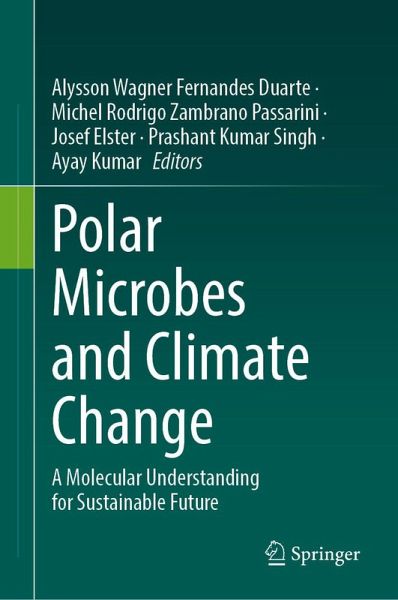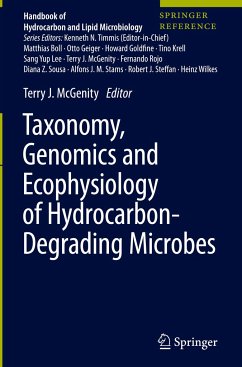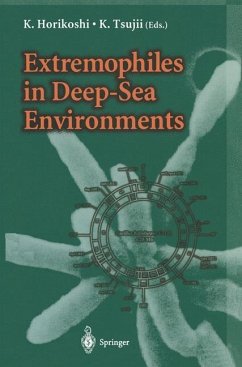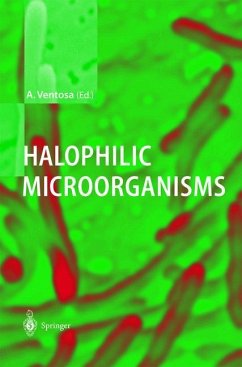
Polar Microbes and Climate Change
A Molecular Understanding for Sustainable Future
Herausgegeben: Fernandes Duarte, Alysson Wagner; Passarini, Michel Rodrigo Zambrano; Elster, Josef; Singh, Prashant Kumar; Kumar, Ayay
Versandkostenfrei!
Erscheint vorauss. 6. Dezember 2025
151,99 €
inkl. MwSt.

PAYBACK Punkte
76 °P sammeln!
Recent studies on extremophiles have focused on thermophiles, microbes that thrive in high temperatures, while psychrophiles, which prefer cold environments, have received less attention. However, interest in cold-adapted microbes, especially those in polar regions, has increased significantly in recent decades. Given that much of Earth s biosphere remains below 5°C, psychrophiles likely outnumber thermophiles. Oceans, covering over 75% of the planet, maintain deep water temperatures between 2 4°C. Antarctica offers both terrestrial and aquatic cold habitats, including ice that melts seasona...
Recent studies on extremophiles have focused on thermophiles, microbes that thrive in high temperatures, while psychrophiles, which prefer cold environments, have received less attention. However, interest in cold-adapted microbes, especially those in polar regions, has increased significantly in recent decades. Given that much of Earth s biosphere remains below 5°C, psychrophiles likely outnumber thermophiles. Oceans, covering over 75% of the planet, maintain deep water temperatures between 2 4°C. Antarctica offers both terrestrial and aquatic cold habitats, including ice that melts seasonally. Other cold ecosystems include permafrost, alpine soils, cold deserts, marine sediments, glaciers, and sea ice.
This book explores microbial diversity and adaptation in extreme polar environments, emphasizing their potential for biotechnological applications. It presents a comprehensive overview of molecular diversity and genetic adaptations in cold-loving microorganisms. The chapters detail representative microbial groups, their habitats, and survival strategies in frigid conditions. It is designed for scientists interested in how life persists in extreme cold.
To survive in such harsh climates, polar microbes have evolved specific regulatory mechanisms to respond to environmental stressors. Over the past decade, research has uncovered microbial responses to anthropogenic challenges like UV-B radiation, nutrient scarcity, desiccation, heavy metals, and temperature extremes. These studies have provided the basis for understanding gene regulatory pathways involved in morphological, physiological, and metabolic adaptations.
Despite advances, the molecular diversity and adaptation mechanisms of polar microbes remain poorly studied. Research is dispersed, and there is a need for a unified resource. This book aims to fill that gap by offering a complete, up-to-date atlas of microbial life in polar regions, highlighting their unique adaptations and potential for future scientific and industrial exploration.
This book explores microbial diversity and adaptation in extreme polar environments, emphasizing their potential for biotechnological applications. It presents a comprehensive overview of molecular diversity and genetic adaptations in cold-loving microorganisms. The chapters detail representative microbial groups, their habitats, and survival strategies in frigid conditions. It is designed for scientists interested in how life persists in extreme cold.
To survive in such harsh climates, polar microbes have evolved specific regulatory mechanisms to respond to environmental stressors. Over the past decade, research has uncovered microbial responses to anthropogenic challenges like UV-B radiation, nutrient scarcity, desiccation, heavy metals, and temperature extremes. These studies have provided the basis for understanding gene regulatory pathways involved in morphological, physiological, and metabolic adaptations.
Despite advances, the molecular diversity and adaptation mechanisms of polar microbes remain poorly studied. Research is dispersed, and there is a need for a unified resource. This book aims to fill that gap by offering a complete, up-to-date atlas of microbial life in polar regions, highlighting their unique adaptations and potential for future scientific and industrial exploration.












